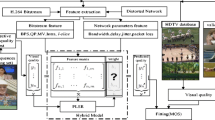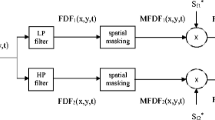Abstract
Due to the variability of wireless channel state, video quality monitoring became very important for guaranteeing users’ Quality of Experience (QoE). QoE presents the overall perceptual quality of service from the subjective users’ perspective. However, because of diverse characteristics of video content, Human Visual System (HVS) cannot give the same attention to whole scene simultaneously when facing video sequence. In this paper, we proposed a video quality assessment model by considering the influence of fast motion and scene change. The motion change contribution factor and scene change contribution factor are defined to quantify the characteristics of video content, which is closely related to the users’ QoE. Based on G.1070, our proposed model considers the influential factors of loss nature of video coding, variability of practical network and video features. Also, the proposed model owns low computational complexity due to the compressed domain approach for the estimation of the model parameters. Therefore, the video quality is assessed without fully decoding the video stream. The performance of our proposed model has been compared with five existing models and the results also shown that our model has high prediction accuracy closing to human perception.









Similar content being viewed by others
References
[Online]. Available: http://iphome.hhi.de/suehring/tml/download/
Chen Y, Wu K, Zhan Q (2015) From QoS to QoE: a survey and tutorial on state of art, evolution and future directions of video quality analysis. IEEE Commun Surv Tutorials 17(2):1126–1165
Chikkerur S, Sundaram V, Reisslein M, Karam L (2011) Objective video quality assessment methods: a classification, review, and performance comparison. IEEE Trans Broadcast 57(2):165–182
Eden A (2007) No-reference estimation of the coding PSNR for H.264-coded sequences. IEEE Trans Consum Electron 53(2):667–674
Ichigaya A, Nishida Y, Nakasu E (2008) No reference method for estimating PSNR of MPEG-2 coded video by using DCT coefficients and picture energy. IEEE Trans Circuits Syst Video Technol 18(6):817–826
ITU-R BT.500-11(2002) Methodology for the subjective assessment of the quality of television pictures
ITU-T G.1070 (2007) Opinion model for video-telephony applications
Joskowicz J, Ardao JCL (2009) Enhancements to the opinion model for video-telephony applications. Proceeding of the 5th Int LANC 87–94
Joskowicz J, Ardao JCL (2010) A general parametric model for perceptual video quality estimation. IEEE Int Workshop Tech Comm CQR 1–6
Ju Y, Lu Z, Ling D, Wen X, Zheng W, Ma W (2014) QoE-based cross-layer design for video applications over LTE. Multimed Tools Appl 72(2):1093–1113
Kanumuri S, Cosman PC, Reibman AR, Vaishampayan VA (2006) Modeling packet-loss visibility in mpeg-2 video. IEEE Trans Multimedia 8(2):341–355
Kim HJ, Choi SG (2013) QoE assessment model for multimedia streaming services using QoS parameters. Multimed Tools Appl 72(3):2163–2175
Li F, Ren P, Du Q (2012) Joint packet scheduling and subcarrier assignment for video communications over downlink OFDMA systems. IEEE Trans Veh Technol 61(6):2753–2767
Lin T-L, Kanumuri S, Zhi Y, Poole D, Cosman PC, Reibman AR (2010) A versatile model for packet loss visibility and its application to packet prioritization. IEEE Trans Image Process 19(3):722–735
Masry M, Hemami SS, Sermadevi Y (2006) A scalable wavelet-based video distortion metric and applications. IEEE Trans Circuits Syst Video Technol 16(2):260–273
Pinson MH, Wolf S (2004) A new standardized method for objectively measuring video quality. IEEE Trans Broadcast 50(3):312–322
Porikli F, Bovik A, Plack C et al (2011) Multimedia quality assessment. IEEE Signal Process Mag 28(6):163–177
Saad MA, Bovik AC, Charrier C (2014) Blind prediction of natural video quality. IEEE Trans Image Proc 23(3):1352–1365
Seshadrinathan K, Bovik AC (2007) A structural similarity metric for video based on motion models. IEEE Int Conf ASSP 1:869–872
Seshadrinathan K, Bovik AC (2010) Motion tuned spatio-temporal quality assessment of natural videos. IEEE Trans Image Process 19(2):335–350
Singh S, Oyman O, Papathanassiou A (2012) Video capacity and QoE enhancements over LTE. IEEE Int Conf Commun 7071–7076
Søgaard J, Forchhamme S, Korhonen J (2015) No-reference video quality assessment using codec analysis. IEEE Trans Circuits Syst Video Technol 25(10):1637–1650
van den Branden Lambrecht CJ, Verscheure O (1996) Perceptual quality measure using a spatio-temporal model of the human visual system. Electronic Imaging: Science & Technology. Int Soc Opt Photonics 450–461
Vriendt JD, Vleeschauwer DD, Robinson DC (2014) QoE model for video delivered over an LTE network using HTTP adaptive streaming. Concurr Comp Pract E 18(4):45–62
Wang Z, Bovik AC, Sheikh HR, Simoncelli EP (2004) Image quality assessment: from error visibility to structural similarity. IEEE Trans Image Process 13(4):600–612
Wang Z, Lu L, Bovik AC (2004) Video quality assessment based on structural distortion measurement. Signal Process Image Commun 19(2):121–132
Watson A, Hu J, McGowan J (2001) Digital video quality metric based on human vision. J Electron Imaging 10(1):20–29
Xiao F (2000) DCT-based video quality evaluation. Final Project for EE392J 769
Yang F, Song J, Wan S (2012) Content-adaptive packet-layer model for quality assessment of networked video services. IEEE J Sel Top Sign Process 6(6):672–683
Zhang X, Lin W, Xue P (2008) Just-noticeable difference estimation with pixels in images. J Vis Commun Image Represent 19(1):30–41
Acknowledgments
This research work was supported in part by National Science Foundation of China 61372091, and the Fundamental Research Funds for the Central Universities.
Author information
Authors and Affiliations
Corresponding author
Rights and permissions
About this article
Cite this article
Zhang, H., Li, F. & Li, N. Compressed-domain-based no-reference video quality assessment model considering fast motion and scene change. Multimed Tools Appl 76, 9485–9502 (2017). https://doi.org/10.1007/s11042-016-3558-0
Received:
Revised:
Accepted:
Published:
Issue Date:
DOI: https://doi.org/10.1007/s11042-016-3558-0




